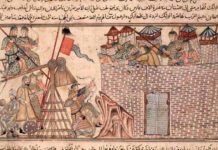In a civilization as intensely spiritual and complex as that of ancient India, no event as important as consecrating a new King could not take place without a heavy freight of ritual and symbolism. So many rules and regulations were prescribed that scribes and advisors were required to master a mass of material to make sure that everything took place according to the specified ceremonies and precedents.
First of all, there was an ideal age and stage of life for a new king. He, and it must be a he, should have started to demonstrate his prowess on the field of battle by the age of sixteen, to have married an official queen two or three years later and, by the age of 23 or 24, was considered to be the perfect age. By that stage, he would have established his own household and harem, perhaps with a few successors already lined up and a settled senior staff.
Preparations for the consecration would take some months. The prince himself would proceed through a series of consultations with important figures in the realm: queen, charioteer, superintendent of gaming and hunting, harem ‘queen,’ head artist and so forth. Meanwhile, the royal astrologers were busy calculating the appropriate moment for the consecration to take place.
A range of dates was prepared, giving a window of about twelve days in which all the necessary ceremonies and rituals could occur. The senior brahmans would also be consulted, both for a ritual purpose and also no doubt to try to reduce the likelihood of there being dissent in the country. For the same reason, foreign ambassadors and leading economic actors would also have been treated to royal hospitality, with more or less attention to religious protocol.
The place of coronation would be inside a large pavilion, perhaps a tent, in which the goods and precious items of the country would be stacked. These were considered to be the tribute offered voluntarily and joyfully by the people, although it is not of course clear just how joyful all of the people would be. The king would be prepared with lustral waters drawn from the Ganges and all the other holy rivers of India.
The chief priest would also anoint the king with sacred fluids, including honey, ghee and the genital fluid of a calving cow. The palace and the streets of the city were, meanwhile, decorated with linen, pearls and precious things of all descriptions. Music was played and the people decorated themselves and prepared for a holiday. It was occasions such as these which punctuated the endless grind of work and poverty for the mass of the people.








